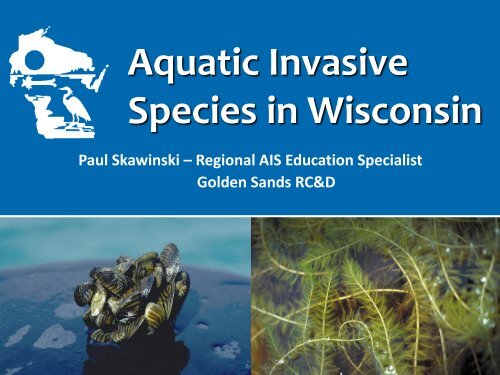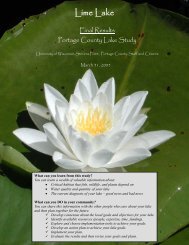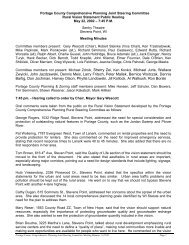Aquatic Invasive Species, Rivers, and You - Portage County
Aquatic Invasive Species, Rivers, and You - Portage County
Aquatic Invasive Species, Rivers, and You - Portage County
Create successful ePaper yourself
Turn your PDF publications into a flip-book with our unique Google optimized e-Paper software.
<strong>Aquatic</strong> <strong>Invasive</strong><br />
<strong>Species</strong> in Wisconsin<br />
Paul Skawinski – Regional AIS Education Specialist<br />
Golden S<strong>and</strong>s RC&D
What are <strong>Invasive</strong> <strong>Species</strong>?<br />
<strong>Species</strong> that can “take over”<br />
an ecosystem<br />
Most problematic invasive<br />
species are exotic to this area<br />
Successful because:<br />
Few or no natural predators, parasites, etc.<br />
Very aggressive, prolific, more fit than natives
How do they get here?<br />
Shipping - ballast water<br />
Intentional introduction - stocking<br />
Canals - migration from the ocean<br />
Nursery industry<br />
Anglers/Bait industry<br />
Aquaculture<br />
Aquarium trade
How do they get here?<br />
Shipping - ballast water<br />
Intentional introduction - stocking<br />
Canals - migration from the ocean<br />
Nursery industry<br />
Anglers/Bait industry<br />
Aquaculture<br />
Aquarium trade
How do they spread?<br />
Boaters<br />
Anglers<br />
Other water users (sea<br />
planes, SCUBA, etc)<br />
Water garden &<br />
aquarium owners<br />
Natural dispersal
How do they spread?<br />
Boaters<br />
Anglers<br />
Other water users (sea<br />
planes, SCUBA, etc)<br />
Water garden &<br />
aquarium owners<br />
Natural dispersal
Why do we care?<br />
Biodiversity decreases<br />
Property values<br />
Swimming<br />
Sport fishing<br />
Tourism dollars<br />
Commercial fishing<br />
Food web impacts<br />
Boating<br />
Fishing<br />
Stunted fish populations
Zebra Mussels<br />
Ballast water introduction to the<br />
Great Lakes in 1980’s<br />
Present in 131 WI inl<strong>and</strong> lakes<br />
(Nov 2010)<br />
Attach to any hard surface - may<br />
reach tens of thous<strong>and</strong>s per<br />
square meter!<br />
Are microscopic in early life<br />
stages<br />
Female can produce 1 million<br />
eggs/season
Eaten on small scale<br />
by some animals<br />
Zebra Mussels<br />
Currently no<br />
management option
Zebra<br />
Mussel<br />
Distribution<br />
[1 lake in <strong>Portage</strong><br />
<strong>County</strong>]<br />
• Lake Wazeecha
Zebra<br />
Mussel<br />
Distribution<br />
[Not detected in<br />
Marathon <strong>County</strong>]
Eurasian Water-milfoil<br />
First found in WI in<br />
1960s<br />
Currently found in 540<br />
WI lakes (Nov 2010)<br />
Forms dense mats -<br />
interferes with water<br />
recreation<br />
Can spread from small<br />
fragments
Eurasian Watermilfoil Spread
Eurasian Watermilfoil Spread<br />
Uh oh
Eurasian Watermilfoil Spread
Eurasian Watermilfoil Spread
Eurasian Watermilfoil Spread
Adventitious roots
Northern watermilfoil
Northern watermilfoil<br />
Myriophyllum sibiricum<br />
Eurasian watermilfoil<br />
Myriophyllum spicatum
Look-alike NATIVE species<br />
Coontail Elodea<br />
Paul Skawinski<br />
EWM<br />
Paul Skawinski
Bladderworts<br />
Look-alike NATIVE species<br />
Paul Skawinski<br />
White water crowfoot<br />
Paul Skawinski<br />
EWM
Hitchhiking on hitchhikers
Eurasian<br />
Water-milfoil<br />
Distribution<br />
[14 lakes in <strong>Portage</strong><br />
<strong>County</strong>]:<br />
• Lake Wazeecha<br />
• Bear<br />
• Helen<br />
• Lime<br />
• McDill<br />
• Springville<br />
• Thomas<br />
• Sunset<br />
• Pickerel<br />
• Wolf<br />
• Collins<br />
• Dubay<br />
• Pacawa<br />
• Emily
Eurasian<br />
Water-milfoil<br />
Distribution<br />
[2 lakes in Marathon<br />
<strong>County</strong>]:<br />
• Mission Lake<br />
• Wadley Lake<br />
<strong>Rivers</strong>:<br />
• Wisconsin River &<br />
flowages<br />
• Big Rib River<br />
• Eau Claire Flowage
ID tip: Dark, rusty spot<br />
on each side of carapace.<br />
Rusty Crayfish<br />
Paul Skawinski<br />
Brought to WI as bait in<br />
1960s<br />
In 465 inl<strong>and</strong> lakes <strong>and</strong><br />
streams (Nov 2010)<br />
Severely reduce aquatic<br />
vegetation, impacting<br />
spawning<br />
Aggressive; compete with<br />
native crayfish <strong>and</strong> fish for<br />
cover <strong>and</strong> food
Rusty Crayfish<br />
Paul Skawinski
Rusty Crayfish<br />
Distribution in<br />
Marathon <strong>County</strong><br />
•Wadley Lake<br />
• Plover River<br />
•Spring Brook<br />
•Trappe River<br />
•Little Trappe River<br />
•Big Rib River<br />
•Little Rib River<br />
•Wisconsin River<br />
• Flume Creek<br />
• Johnson Creek<br />
•Lake Dubay<br />
•South Branch Embarrass River
Rusty Crayfish<br />
Distribution in<br />
<strong>Portage</strong> <strong>County</strong><br />
Flume Creek<br />
Plover River<br />
Lake Dubay<br />
Amherst Millpond<br />
McDill Pond<br />
Lake Emily<br />
Lake Wazeecha<br />
Mosquito Creek<br />
Springville Pond<br />
Waupaca River<br />
Tomorrow River
Curly-leaf Pondweed<br />
Accidentally introduced as<br />
aquarium plant (1880s)<br />
Fairly widespread – in 382<br />
water bodies (Nov 2010)<br />
Active very early in growing<br />
season – even under ice<br />
Can form dense mats,<br />
interfering with recreation<br />
<strong>and</strong> native plants
Paul Skawinski<br />
Curly-leaf<br />
pondweed turions<br />
Paul Skawinski
Curly-leaf<br />
pondweed turions<br />
Paul Skawinski
Curly-leaf pondweed<br />
distribution in<br />
<strong>Portage</strong> <strong>County</strong><br />
• Spring Lake<br />
• Lake Emily<br />
• Springville Pond<br />
• McDill Pond<br />
• Plover River<br />
• Wisconsin River<br />
• Sunset Lake<br />
• Lime Lake<br />
• Tree Lake<br />
• Jordan Pond<br />
• Amherst Millpond<br />
• Lake Dubay<br />
• Lake Wazeecha
Paul Skawinski<br />
Purple Loosestrife<br />
Imported from Europe for<br />
gardens (late 1800s), also<br />
seeds in ballast water<br />
Crowds out native wetl<strong>and</strong><br />
species<br />
Spreads rapidly: >1 million<br />
seeds annually, plus<br />
vegetative spread
Paul Skawinski<br />
Purple Loosestrife ID<br />
Square stem<br />
Opposite or whorled leaves<br />
Leaf margins are smooth or with<br />
very small teeth<br />
Flowers pink or purple in spike<br />
arrangement, each with 6 petals
Wisconsin’s <strong>Aquatic</strong><br />
<strong>Invasive</strong> <strong>Species</strong> Program<br />
Volunteer Monitoring<br />
Volunteers collect data on<br />
lake health including aquatic<br />
invasives<br />
Data used to map extent of<br />
spread for species<br />
Contact: Laura Herman<br />
715-365-8998
Monitoring is essential to prevention<br />
Get trained on identification of AIS <strong>and</strong> lookalike<br />
native species<br />
Keep an eye out for AIS while fishing, boating,<br />
snorkeling, etc.<br />
Know who to contact with questions or<br />
suspected AIS specimens<br />
Finding invasives early is crucial for<br />
inexpensive, easy management (eradication?)
Questions?<br />
Paul Skawinski<br />
AIS Coordinator – <strong>Portage</strong>, Wood, Waushara,<br />
Marathon Counties<br />
Golden S<strong>and</strong>s Resource Conservation &<br />
Development Council, Inc. (RC&D)<br />
715-343-6278 skawinsp@co.portage.wi.us








